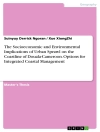This book documents the various impacts of urbanization on hydrological systems and water resources. The first half of the book is focused on urbanization and surface waters, starting with the status of hydrological systems in the urban areas, i.e. the catchment characteristics and changes in rainfall dynamics. The most pronounced hydrological problems in cities are changes in runoff due to precipitation. Recently, rain events have been less frequent but more intense, sometimes leading to flash floods. Though the substantial increase in runoff causes floods in the urbanized area, it may be attributed to the reduction of infiltration due to construction of roads. This, in turn, results in groundwater decline and depletion. The second half of the book covers the impact of urbanization on groundwater, which starts with hindered or significantly reduced recharge taking place due to altered urban surfaces. The limited groundwater resources are over-exploited by the urban population, leading to water scarcity and depletion. Groundwater gets polluted due to solid waste dumping sites or by wastewaters discharged by industries. The book will be useful for researchers, educators, municipal/city authorities, government officials, and NGOs.
Tabella dei contenuti
Chapter1. GIS-based Multi-Criteria Decision Analysis for Identifying Rainwater Harvesting Structures Sites in a Semi-Arid River Basin.- Chapter2. Hydrochemical Investigation and Water Quality Mapping in and around Pallikarnai Marsh Land Area in Chennai, India.- Chapter3. Catchment Scale Modeling of Land Use and Land Cover Dynamics.- Chapter4. Urban Floods: A Case Study of Patna Floods 2019, Natural or Anthropogenic?- Chapter5. Flood Susceptibility Zonation using Dempster-Shafer Evidential Belief Function (EBF) Method in Chalakudy Taluk, Kerala, India.- Chapter6. Impact of Urbanization on Ganga River Basin: An Overview in the Context of Natural Surface Water Resources.- Chapter7. Urban Water Scarcity: A Global Challenge and Impending Solutions.- Chapter8. Groundwater Scarcity in Urban Areas is a Major Issue – Case Studies from West Bengal.- Chapter9. Impact of Urbanization and River Morphology on Groundwater System in Patna Urban Area, Bihar, India.- Chapter10. Aquifer Storage and Recovery: Key Issues and Feasibility.- Chapter11. Temporal Prediction of Groundwater Levels: A Gap in Generalization.- Chapter12. Suitability of Groundwater for Drinking and Agricultural Use in Patna District, Bihar, India.- Chapter13. Groundwater Potential Assessment using GIS-based Weighted Linear Combination Technique: A Case Study of Hard Rock Terrain around Bhopal, India.- Chapter14. The Effect of Urbanization on Groundwater Quality and Hydrochemical Characteristics in Ennore Coastal Aquifers of Chennai, South India.- Chapter15. Groundwater Contamination in Parts of Northwestern Hyderabad- A Hydrogeochemical and Geospatial Approach.- Chapter16. Spatio-Temporal Dynamics of Groundwater Recharge in Dras Sub-Basin of Upper Indus River Basin, Western Himalayas.- Chapter17. Impact of Urbanization on Groundwater in Changing Climatic Scenario: A Case Study.
Circa l’autore
Dr. P Thambidurai is an Assistant Professor in the Department of Coastal Disaster Management at Pondicherry University – Port Blair Campus, Andaman, India. He received his Ph.D. in Hydrogeology from the Department of Earth Sciences, Indian Institute of Technology Bombay, India and Gian Maria Zuppi scholarship for high-achieving in research in the international student category, awarded by the University of Venice during his doctoral degree. He completed his graduate and post-graduate degrees from Periyar University, Salem, India. He joined Amrita Vishwa Vidyapeetham, Kerala as a Research Associate after finishing his Ph.D. in 2015 and then, served there as an Assistant Professor till 2018. He has intensive field and consultancy experiences in Geo Technical Mining Solution, Dharmapuri, Tamil Nadu, India.
He has vast field experience in hydrogeology, where he contributed to building the national level policy called Revitalization of Rivers in India Draft Recommendation – The Fundamentals to improve the groundwater and surface water resources. This River policy has been adopted by Government of India – Ministry of Environment, Forest & Climate Change and Jal Sakthi to Rejuvenate 13 major rivers in India. He has published about 20 scientific articles in international journals, conference proceedings, and book chapters.
Dr. Anil Kumar Dikshit is Higher Administrative Grade (HAG) Professor in the Environmental Infrastructure & Clean Tech (EICT) Group and In-charge of GIS Laboratory for Environmental Management & Sustainability (GEMS) of the Environmental Science and Engineering (ESE) Department at Indian Institute of Technology, Bombay, India. He did his graduation and masters’ in Civil Engineering in 1985 and 1987, respectively and completed Ph.D. in Civil and Environmental Engineering from Cornell University, USA in the year 1994.
He has more than 30 years of experiencein Teaching, Research and Consultancy at IIT Kanpur, Cornell University, IIT Kharagpur and IIT Bombay, Kigali Institute of Science & Technology, Rwanda; University of Kwazulu-Natal, South Africa; Nanyang Technological University, and National University of Singapore, Singapore; Malardalen University, Sweden; and Asian Institute of Technology, Bangkok. He has guided 40 masters’ and 22 doctoral scholars while 6 research scholars are working on their Ph Ds. He has also worked on more than 150 national and international research and consultancy projects. The results of academic research work have provided 1 patent, 8 books, 11 chapters in edited books, 200 reports, 150 publications in international & national journals, 140 in international & national conferences while many more papers are under review. In addition, more than 20 prototypes / equipment related to various environmental pollution management topics; academic versions of more than 10 environmental modeling and simulation software(s); and about 7 GIS applications on environmental management problems have been developed under his guidance.












